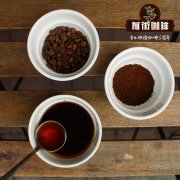Description of taste and flavor of Mexican Chiapas coffee beans Starbucks Chiapas coffee brewing techniques

Professional coffee knowledge exchange more coffee bean information please follow the coffee workshop (Wechat official account cafe_style)
Chiapas / Mexican coffee
The United States of Mexico (English: Mexico; Spanish: Los Estados Unidos Mexicanos), or Mexico for short, is a federal republic of North America, bordering the United States to the north, the Pacific Ocean to the south and west, the Caribbean Sea to the southeast, Belize and Guatemala to the southeast, and the Gulf of Mexico to the east. The ancient Mexican Indians cultivated corn, so Mexico is known as "the hometown of corn". In different historical periods, Mexico has also won the reputation of "country of cactus", "kingdom of silver", "country floating on the sea of oil" and so on.
The best coffee in Mexico comes from the southeastern state of Chiapas.
The state, which is adjacent to Guatemala and has a good geographical environment and climate, is known as the perennial rainforest and has an amazingly rich biosphere. Forest areas include jaguars, flying squirrels, monkeys, white-tailed deer, giant beaked birds, parrots and so on. It is also one of the poorest states in Mexico.
Chiapas / Starbucks & Mexico
Starbucks has been trying to provide coffee farmers with a better and fairer platform.
Coffee rust has always been an extremely troublesome problem for coffee farmers, either spending a lot of money to create a pest-free growth environment, or improving the genes of coffee trees to make them resistant. Obviously, the latter is more practical for poor coffee farmers.
Coffee rust (Coffee rust)
The disease can be said to be the most destructive coffee tree disease, caused by coffee camel rust (Hemileia vastatrix). The disease has long occurred in coffee-producing areas such as Africa, the near East and India, Asia and Australasia. It first appeared in the Western Hemisphere in 1970 and was found in Brazil. Once thriving coffee plantations in Sri Lanka and Java were destroyed by the disease. The symptoms are small yellow oil spots on the surface of the leaves, then expand into bright orange to red spots, and finally turn brown with yellow edges. The rust spore pile is located on the lower surface of the leaf, orange-yellow, and then turns black. The diseased leaves droop and fall off gradually, and the plant dies within a few years. (from Baidu encyclopedia)
Martiniano Moreno spent more than 30 years growing coffee on a farm near La Frailesca in Chiapas, Mexico. Moreno's decades-long planting experience did not help him fight coffee rust.
"Rust has damaged our production and reduced it by 40-60%," said Moreno, who supports a family of eight. "it's ugly." Our whole community depends on coffee. This is the way we take care of our families and raise our children.
However, Moreno's recent visit to a nursery near the village of Jaltenango gave him new hope. Moreno was invited to plant 3000 new rust-resistant coffee trees. The saplings are donated by Starbucks Mexico to coffee farmers in Chiapas through a program called TODOS SEMBRAMOS CAFE (we all grow coffee).
When Starbucks distributed the plants, Moreno was one of the first 60 coffee farmers to accept donations. And Starbucks provided a total of 18000 rust-resistant coffee saplings at that time.
For Starbucks, this marks an important milestone in its long journey to grow coffee in Chiapas.
"I have seen with my own eyes the damage that coffee rust has done to farmers. The planting of these rust-resistant coffee trees has had a positive impact on helping farmers and their families in the coming years, "Craig Russell, executive vice president of Starbucks Global Coffee, said in a statement.
"Chiapas is a major producer of premium Arabica coffee," said Federico Tegado, chief executive of Starbucks Mexico. "We have a strong tradition of building long-term relationships with major coffee producers around the world with the aim of providing resources and training to improve crop quality and maintain stability."
Starbucks Mexico donated three coffee trees to farmers in Chiapas. These varieties are known for producing better yields, higher cup quality and enhanced antirust capabilities-Costa Rica 95, Guacamaya (King Kong) and Marseilles.
When the first phase of TODOS SEMBRAMOS is over, Starbucks Mexico is still committed to expanding the project. In cooperation with agronomists, the company plans to develop a tailored plan with each coffee producer and visit regularly to assist in plant nutrition, soil analysis, PH assessment and identify possible pests and diseases.
Chiapas / Starbucks Chiapas
This is a Single Origin coffee bean, but it contains not only coffee beans, but also the endless yearning of Mexican coffee farmers for a better life and the wonderful connection between Starbucks and local coffee farmers.
Flavor: refreshing acidity and nutty flavor.
Ming uses three ways to cook this kind of beans.
① classic hand punch
Grind 30g powder and stew normally. The starting point of cooking can be a little finer.
Caption: bright acidity, obvious nutty flavor, medium body, slightly sweet.
② elegant hand flushing (ice)
40g powder, wet the filter paper, take out the filter paper, cool the bottom of the filter cup with a small amount of ice, pour out the ice for cooling, put in 380g ice, add the filter paper, pour in the coffee powder, stew with 80g water (the steaming time is 30s at the beginning of water injection), the second water injection to 250g, wait for 30s, the third water injection to 320g, the total time 2min10s cut off.
Description: fresh and crisp acidity, smooth nuts. Body is more round and sweet than ①.
③ Kalita three holes
Description: the lowest acidity of the three, thick body, rich nutty flavor, chocolate finish.
Related recommendation: is hand-made coffee really good? Why does coffee smell better than it tastes?
Important Notice :
前街咖啡 FrontStreet Coffee has moved to new addredd:
FrontStreet Coffee Address: 315,Donghua East Road,GuangZhou
Tel:020 38364473
- Prev

What are the brands of Mexican coffee beans? what are the varieties of Mexican coffee grown?
Professional coffee knowledge exchange more coffee bean information Please follow the coffee workshop (Wechat official account cafe_style) when you have a cup of coffee, what do you think of it? Bitter, sour? Catchy, mellow? A cup of coffee, in addition to the enjoyment of the taste, the origin, planting mode and producer story behind it are more for us to savor. Mexico is an exotic place.
- Next

Guerrero Guerrero Manor in Mexico introduces the flavor of coffee beans treated with SHG sun honey.
Professional coffee knowledge exchange more information about coffee beans Please pay attention to the coffee workshop (Wechat official account cafe_style) Mexican coffee beans may not be well known, but they are worth paying attention to. Chiapas is the most stable coffee producing area in Mexico, with a high concentration of sweetness and lingering taste. Mexico is a big country in Central America and an important coffee producer in the world.
Related
- Detailed explanation of Jadeite planting Land in Panamanian Jadeite Manor introduction to the grading system of Jadeite competitive bidding, Red bid, Green bid and Rose Summer
- Story of Coffee planting in Brenka region of Costa Rica Stonehenge Manor anaerobic heavy honey treatment of flavor mouth
- What's on the barrel of Blue Mountain Coffee beans?
- Can American coffee also pull flowers? How to use hot American style to pull out a good-looking pattern?
- Can you make a cold extract with coffee beans? What is the right proportion for cold-extracted coffee formula?
- Indonesian PWN Gold Mandrine Coffee Origin Features Flavor How to Chong? Mandolin coffee is American.
- A brief introduction to the flavor characteristics of Brazilian yellow bourbon coffee beans
- What is the effect of different water quality on the flavor of cold-extracted coffee? What kind of water is best for brewing coffee?
- Why do you think of Rose Summer whenever you mention Panamanian coffee?
- Introduction to the characteristics of authentic blue mountain coffee bean producing areas? What is the CIB Coffee Authority in Jamaica?

